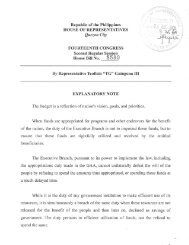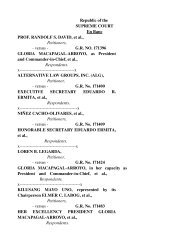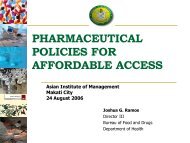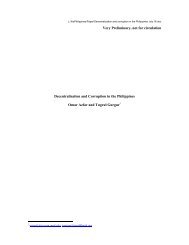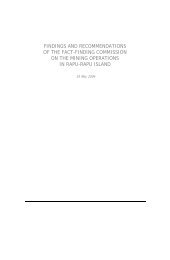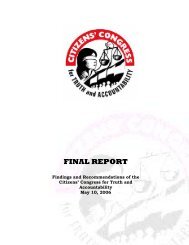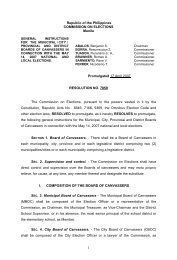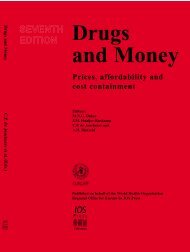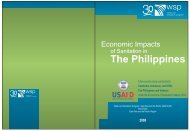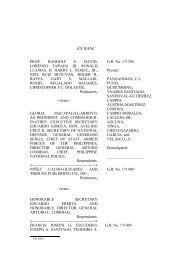The state of water resources in the Philippines - Greenpeace
The state of water resources in the Philippines - Greenpeace
The state of water resources in the Philippines - Greenpeace
You also want an ePaper? Increase the reach of your titles
YUMPU automatically turns print PDFs into web optimized ePapers that Google loves.
As <strong>state</strong>d <strong>in</strong> <strong>the</strong> EMB report, domestic waste<strong>water</strong> discharges contribute highest<br />
to <strong>the</strong> BOD load as <strong>the</strong> lack <strong>of</strong> sewage treatment system allows more than 90<br />
percent <strong>of</strong> <strong>in</strong>adequately treated domestic sewage to be discharged <strong>in</strong>to surface<br />
<strong>water</strong>s, which conta<strong>in</strong> bacteria and viruses that threaten human life.<br />
Geographically, data show that one-third (30 percent) <strong>of</strong> BOD generation comes<br />
from Metro Manila and Region IV alone, at 18 and 15 percent, respectively (PEM,<br />
2003).<br />
Agricultural waste<strong>water</strong><br />
Agriculture and livestock activities <strong>in</strong>clude <strong>the</strong> rais<strong>in</strong>g or production <strong>of</strong> hogs,<br />
chicken, cattle, and o<strong>the</strong>r dairy farm<strong>in</strong>g activities, all <strong>of</strong> which generate high<br />
organic waste<strong>water</strong>. A number <strong>of</strong> <strong>the</strong>se farms, <strong>in</strong>clud<strong>in</strong>g backyard animal farms,<br />
have no appropriate waste<strong>water</strong> treatment facilities. This is considered as <strong>the</strong><br />
major source <strong>of</strong> pollution <strong>in</strong> rural areas (EMB, 2006; PEM, 2003).<br />
Data also show that <strong>the</strong> major sources <strong>of</strong> agricultural run<strong>of</strong>fs <strong>in</strong>clude organic<br />
wastes such as decayed plants, livestock manure, and dead animals; soil loss <strong>in</strong><br />
<strong>the</strong> form <strong>of</strong> suspended solids; and pesticides and fertilizer residues (PEM, 2003).<br />
Apart from pollution <strong>of</strong> surface <strong>water</strong>s, <strong>the</strong>re are studies that show <strong>the</strong> impacts <strong>of</strong><br />
us<strong>in</strong>g agrochemical <strong>in</strong>puts on ground<strong>water</strong> <strong>resources</strong>, especially dur<strong>in</strong>g <strong>the</strong> wet<br />
season (Varca, L, 2002).<br />
Regions IV and I generate <strong>the</strong> highest load <strong>of</strong> agricultural BOD account<strong>in</strong>g for 13<br />
and 12 percent <strong>of</strong> <strong>the</strong> total agricultural BOD generation, respectively (PEM,<br />
2003).<br />
Industrial waste<strong>water</strong><br />
Reports show that <strong>the</strong> volume and characteristics <strong>of</strong> <strong>in</strong>dustrial effluents vary by<br />
type <strong>of</strong> <strong>in</strong>dustry and are <strong>in</strong>fluenced by different factors such as production<br />
processes and <strong>the</strong> scale <strong>of</strong> production used.<br />
Industries that are found to be <strong>water</strong>-<strong>in</strong>tensive, i.e. food and dairy manufactur<strong>in</strong>g,<br />
pulp, paper and paperboard products, and textile products, correspond<strong>in</strong>gly<br />
discharge large amounts <strong>of</strong> waste<strong>water</strong> (PEM, 2003).<br />
Most <strong>of</strong> <strong>the</strong> <strong>water</strong> pollution-<strong>in</strong>tensive <strong>in</strong>dustries are <strong>in</strong> National Capital Region,<br />
Calabarzon, and Region III. Food manufactur<strong>in</strong>g <strong>in</strong>dustries, piggeries, and<br />
slaughterhouses are <strong>the</strong> ma<strong>in</strong> sources <strong>of</strong> organic pollution (PEM, 2004).<br />
A report from a study conducted by <strong>the</strong> United Nations Industrial Development<br />
Organization (UNIDO) <strong>in</strong> 1999 emphasizes that <strong>the</strong> situation is even more critical<br />
with regard to hazardous wastes. In <strong>the</strong> said report, approximately 2,000 cubic<br />
meters <strong>of</strong> solvent wastes, 22,000 tons <strong>of</strong> heavy metals, <strong>in</strong>fectious wastes,<br />
biological sludge, lubricants, and <strong>in</strong>tractable wastes, as well as 25 million cubic<br />
meters <strong>of</strong> acid/alkal<strong>in</strong>e liquid wastes are improperly disposed <strong>of</strong> annually <strong>in</strong> <strong>the</strong><br />
Metro Manila area alone.<br />
GREENPEACE | <strong>The</strong> <strong>state</strong> <strong>of</strong> <strong>water</strong> <strong>in</strong> <strong>the</strong> Philipp<strong>in</strong>es 19



